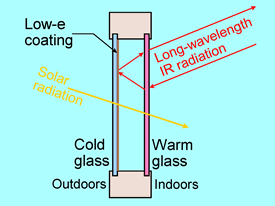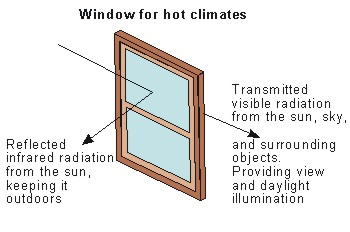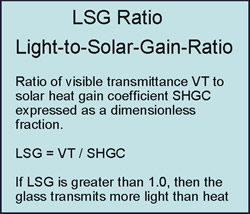
![]()
![]() In recent years, national window manufacturers have greatly expanded the
selection of energy efficient and attractive windows, but for many years
the focus was on cold northern climates.
In recent years, national window manufacturers have greatly expanded the
selection of energy efficient and attractive windows, but for many years
the focus was on cold northern climates.
Coatings for cold climate windows. With the advent of large machines for coating glass sheets in a vacuum, a new technology was introduced in the 80s. The so-called low-e coatings offered even greater insulation of a building's interior spaces from cold outside air temperatures. These coatings are applied to one of the interior glass surfaces and work by reducing the emission of long-wavelength infrared radiation from the warmer interior pane of glass, or by reflecting that radiation from the outer pane back to the inner pane.
 The result was a reduction of heat loss from the warm interior to the cold
exterior on cold winter nights. Such windows are excellent at admitting solar
heat, while preventing its escape back outside. This ability of these very
well insulated windows to trap heat inside is a boon for northern homeowners.
The result was a reduction of heat loss from the warm interior to the cold
exterior on cold winter nights. Such windows are excellent at admitting solar
heat, while preventing its escape back outside. This ability of these very
well insulated windows to trap heat inside is a boon for northern homeowners.
Not good for hot climates. For sunbelt homes, the coatings designed for cold climate heat loss prevention can be a disaster on windows in hot climates—at least in terms of the discomfort they produce—due to localized overheating and sun glare. When they face east or west directions and are unshaded, these northern windows are also excellent for capturing the heat of the early morning or late afternoon sun and trapping it inside, making air conditioning bills soar. FSEC scientists and engineers have found that, for much of Florida, it makes sense to put your dollars into blocking solar heat gain, rather than purchasing insulated, conventional low-e windows.
Coatings for hot climate windows. In
the 90s a new kind of coating designed for hot southern climates
was introduced. The generic
name for the new technology is low solar gain low-e coating, but
it can also be called hot climate low-e coatings. These new coatings
work by extending the spectral selectivity characteristic of a conventional
high solar gain low-e coating, bringing it from outside the solar spectrum
to the edge of the visible portion of that spectrum. This is described
in more detail below. The result is a new kind of spectral selectivity
through which the infrared portion of the solar spectrum (accounting for
more than half the energy from the sun) is reflected by the new coating back
outside the building. This invisible reflected solar IR radiation returns to
the outside and is thereby prevented from entering the cool interior of the
building. The result is a major reduction of the solar heat gain through
the window without significant loss of visible light transmitted through
the glass. The new coating reflects almost half of the incident solar
radiation back outside while still allowing copious quantities of daylight
to enter. Thus the window does not appear tinted. It's as bright as
a pane of clear uncoated glass.
This is possible because less than half the energy in solar radiation incident on a window is visible light. The rest is invisible infrared radiation and a smaller quantity of (also invisible) ultraviolet radiation. The special coating can also be called a strongly spectrally selective one, meaning that it selects out only the visible radiation to be allowed inside. In consequence the solar heat gain through an uninsulated window can be dropped to half what it would be for single pane clear glass, without significant reduction of the admitted daylight. How these new solar IR rejecting coatings work is illustrated in the adjacent spectral plot.
 How
do you know you're getting one of these new sunbelt window glazings?
It's really quite simple. There are two numbers which all window
manufacturers use to tell how good their windows are in admitting both solar
heat and light. The visible transmittance, sometimes called VT,
or Tv, gives the fraction of incident light that is admitted. Look
for this number to be high, ideally above 0.6 to 0.8 (or 60% to 80%).
The other number is called the solar heat gain coefficient, SHGC.
How
do you know you're getting one of these new sunbelt window glazings?
It's really quite simple. There are two numbers which all window
manufacturers use to tell how good their windows are in admitting both solar
heat and light. The visible transmittance, sometimes called VT,
or Tv, gives the fraction of incident light that is admitted. Look
for this number to be high, ideally above 0.6 to 0.8 (or 60% to 80%).
The other number is called the solar heat gain coefficient, SHGC.
Look for this number to be as low as possible for hot climate applications, ideally below 0.4 (or 40%). By keeping VT high and SHGC low, you can be sure that adequate daylight will be admitted while still blocking significant quantities of solar radiant heat gain. Both VT and SHGC numbers can be found on the energy efficiency label developed by the National Fenestration Rating Council for U.S. windows.
Ross McCluney, Principal Research Scientist at FSEC, has defined the ratio of VT to SHGC to be the light-to-solar gain ratio, or LSG, and this terminology is widely accepted in the window industry. The higher this number is, the greater the spectral selectivity, a desirable characteristic of glazing systems for hot climates.
 The
new spectrally selective coating offered by glass and window manufacturers
for hot climates is characterized by a high value of the LSG. High-LSG
glass is offered by many window manufacturers, but few retail vendors
are knowledgeable about it.
The
new spectrally selective coating offered by glass and window manufacturers
for hot climates is characterized by a high value of the LSG. High-LSG
glass is offered by many window manufacturers, but few retail vendors
are knowledgeable about it.
It is but one available feature of new high performance windows for hot climates. Several other considerations are important in selecting windows and shading devices for hot climates. One of these is the damage-weighted transmittance of the glazing system. Click here for more information about UV Transmittance & Fading.
For more information on this subject, see the Links page. You can also see a more detailed technical treatment of fenestration solar gain if your browser is able to read Adobe Acrobat portable document format (PDF) files by clicking on: Industry Guide to Selecting the Best Residential Windows for your Florida Home.
